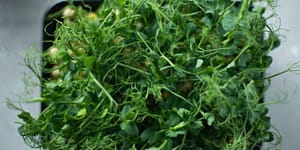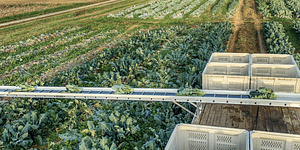15 Questions to Ask When Designing Your Garden

There are a lot of things to take into consideration when designing your garden: When to plant, where to plant, how to plant, and so on.
In order to answer these questions, you first have to answer a much broader one: “How can I work with nature to make this garden regenerative and sustainable?” If we let go of the power we have (or think we have) over nature and instead work with it, our gardens turn out so much better. The first step in this process? Asking questions about your environment to properly design your garden.
The following is an excerpt from The Ecological Gardener by Matt Rees-Warren. It has been adapted for the web.
(All photographs courtesy of Matt Rees-Warren.)
What To Ask When Designing Your Garden
There is no one single way to design a garden. Styles and traditions may have influence, but these are only motifs from which each garden inevitably departs. Every garden is unique, reflecting the environment and landscape it exists within as well as the hand of the gardener who dreamt of its creation and raised it from the ground. Gardens are dynamic; they grow, expand, reproduce, decompose, freeze, bake, dry out, and flood. Mammals, birds, insects, reptiles and microorganisms all live, breathe, sustain and perish within them. Not only do the seasons change but the climate is changing as well, and our gardens will transition with it, however extreme or unpredictable its effects. Gardens are, in short, ecosystems.
Rich, biodiverse environments are complex, but to design a garden ecologically is simple. It requires observing the space we currently garden, or plan to, studying its singular rhythm and unique patterns. It also means letting go of design ideas of the past by letting go of our desire to hold dominion over nature, allowing it instead to lead the way. We must recognise the cycles of upheaval and regeneration that are already ongoing in the garden and work with, not against, them. Nature is capable of producing infinite variety, but as gardeners and designers we hold grave power to diminish its divergency. With thoughtful vision and a light touch, however, we can rebalance the scales. If we design our gardens to be regenerative, the result will be functional, beautiful spaces full of life and vigour, robust enough to face the challenges of the future and elegant enough to beguile all those who walk among them.
Elemental Observation
Design begins in the eye and the mind long before it is sketched on paper or realised on the ground. To begin, it’s important to understand the many and varied elements that make up a natural space. The ecological framework of a garden should be the foundation from which your design arises, and inform your gardening methods thereafter. You don’t need to become a biologist or geologist, only a simple observer, gaining knowledge about your landscape as only you can, and imagining the possibilities from there. And nothing could be simpler than imagining your garden according to the four wild elements: earth, air, fire and water.
The Wild Elements
Observe your garden (or future garden) within the framework of the four elements by asking questions. The answers will then further guide your vision and design.
- What is the topography of the garden? Is the land on a slope or is it flat?
- What is the predominant vegetation of the local and wider environment? Is the land boggy and low-lying or is it by the sea? Does it sit within a temperate forest region or a dry steppe?
- What is the underlying subsoil? Is heavy clay, or is it mainly sand or even chalk?
- What of the life within the topsoil – does it contain many worms and invertebrates, or is it lifeless and inert?
Fire
- From the perspective of the house wall, what direction does the garden face – south or north? Which area of the garden receives the most light?
- Is the garden overburdened by trees, high walls or other buildings, restricting its light? Will the lower winter sun reach over these obstacles?
- Do internal walls naturally collect and accumulate heat? And is the power of this heat energy detrimentally intense and needs calming, or relatively weak and needs amplifying?
Air
- What is your garden’s prevailing localised climate? Is it located in a valley that holds morning fog? Does it experience high levels of humidity?
- Are there microclimates within the garden where frost pockets develop, and does dew collect in the mornings?
- What of the wider climatic zone – is the garden within a coastal region or a temperate forest?
- What direction does the prevailing wind come from? Does the garden require protection from regular strong wind, or should your design encourage wind to cool it down?
Water
- How much rainfall is the garden likely to receive – is water naturally abundant or do you treat it as precious?
- Where in the garden does water collect the most? Does it pool and linger or quickly drain away?
- Are there any watercourses that run through the garden? Any wells or springs?
- Does the water table come high in the winter or stay low the whole year through? Does the garden experience flood or drought, and if so, which areas are affected most by these extremes?
I have found that garden designers often overlook these considerations in pursuit of aesthetical beauty. I too can be seduced by the power of form and craft, but I’ve learnt to train my eye to see beyond the surface to the foundations of garden construction. I’ve learnt this by seeing design not as patterns humans impose on nature, but the fabric of how nature itself works. Every design I have ever drawn has been improved the longer I’ve spent getting to know the space the garden will occupy. In your own space, gaining knowledge of certain conditions in your garden may require slightly more than passive observation. For example, to better understand your underlying subsoil, you can conduct two simple soil and water tests outlined in The Soil Test and The Water Test.
The Soil Test
- Dig a hole 50 cm deep and take a handful of soil from the bottom. Make sure you dig below the topsoil level (figure 1).
- Observe the soil. Is it sandy, or dense and heavy? Does it have rock in it or feel wet?
- Take a thimble-sized amount, add a small amount of water or spit, and roll it into a ball (figure 2). If you can’t do this, you have a sandy soil.
- Take the ball, roll it into a sausage shape and loop this into a circle (figure 3). If it breaks apart, then you have loam.
- If you have been able to form a loop with no cracks in it, then your soil is clay.
The Water Test
- Dig a hole 50 cm deep and a spade’s width wide. Make sure you choose a site on level ground.
- When no rain is forecast, fill the hole to the top with harvested rainwater and check regularly (figure 1).
- If the water drains away quickly, the soil is loose and free-draining. But if it lingers for a long time, the soil is heavy and saturated.
Recommended Reads
How to Grow and Maintain Fruit Trees: General Fruit Tree Management
How to Grow Healthy Plants: Strengthening Your Farm or Garden’s Immune System
Recent Articles
If you love tomatoes, you probably already know just how many varieties of these summertime staples there are. But do you know what makes each one unique?
Read MoreAdding the long game of trees to your system results in a deeper and more reliable, resilient and profound presence to your annual vegetable production.
Read MoreIf you’re ready to start growing a portion of your own food, but you aren’t quite ready for something that requires a big time commitment or a lot of effort, this is a good place to start. Sprouts are easy to cultivate, mature very quickly, can be used in a variety of delicious dishes, and…
Read MoreNothing says “spring” like a fresh, foraged meal! Savor the flavors of the season with this Milkweed Bud Pizza recipe.
Read MoreSo you want to start reaping your harvest, but you’re not sure where to start? Learn how to break down the options of harvesting tools!
Read More











